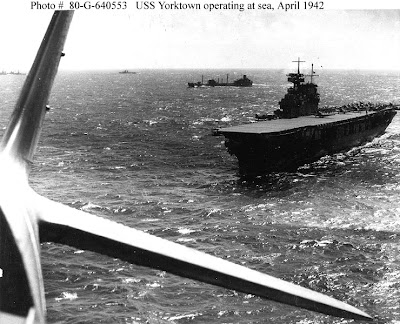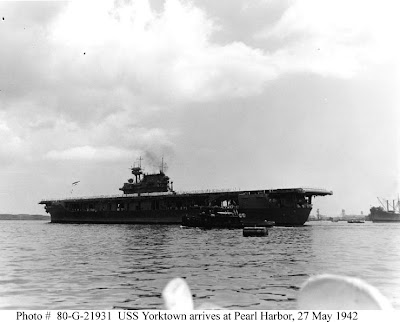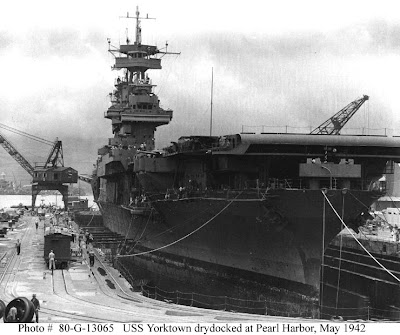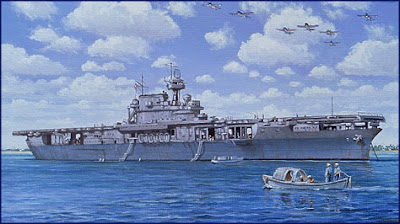Countdown to Midway: 30 May 1942
Britain launches its first 1000-plane bomber raid – the target: Cologne, Germany.
CHINA-BURMA-INDIA:
Myitkyina, Burma is again hit by B-17’s. Again no activity is observed and the attacks are discontinued. HQ 7th Bombardment Group transfers from Karachi to Dum-Dum, India.
ALASKA:
77th Bombardment Squadron (Medium), 28th Composite Group, based at Elmendorf Field, Anchorage, Territory of Alaska, begins operating from Umnak, Aleutian Is with B-26’s.
PACIFIC OCEAN AREA:
7th Air Force begins flying B-17’s from the Territory of Hawaii to Midway in the face of an expected attack on that. 394th Bombardment Squadron (Heavy), 5th Bombardment Group (Heavy), transfers from Hickam Field to Bellows Field, Territory of Hawaii with B-17’s.
 Pearl Harbor: On the 27th of May, USS Yorktown arrived at Pearl Harbor bearing the wounds of her action from the Coral Sea action. Grievously wounded by both direct-hits and near-misses (even while having avoided a spread of eight air-launched torpedoes), Yorktown required at least a three month overhaul and refit. However, Nimitz knew Yorktown was the only carrier available to add to the task force that had previously sailed with Hornet and Enterprise. Two carriers against Kido Butai would not be sufficient – Saratoga, enroute from the West Coast, would not arrive until 7 Jun, too late to be of use. Ranger was otherwise engaged and Lexington, well, Lexington was lost after a valiant fight at Coral Sea. The third carrier had to be Yorktown.
Pearl Harbor: On the 27th of May, USS Yorktown arrived at Pearl Harbor bearing the wounds of her action from the Coral Sea action. Grievously wounded by both direct-hits and near-misses (even while having avoided a spread of eight air-launched torpedoes), Yorktown required at least a three month overhaul and refit. However, Nimitz knew Yorktown was the only carrier available to add to the task force that had previously sailed with Hornet and Enterprise. Two carriers against Kido Butai would not be sufficient – Saratoga, enroute from the West Coast, would not arrive until 7 Jun, too late to be of use. Ranger was otherwise engaged and Lexington, well, Lexington was lost after a valiant fight at Coral Sea. The third carrier had to be Yorktown.
 When she entered Pearl on the 27th, over 1,400 shipyard workers swarmed aboard and immediately set to work repairing the damage, along with ship’s company. On 28 May she entered dry dock to repair cracks in the hull and fuel holding tanks from the near misses. In forty-eight hours another in a series of miracles ensued and Yorktown made ready for sea. At 0900L 30 May 1942, Yorktown put to sea, her airwing replenished with three of Saratoga’s squadrons (VB-3, VF-3 and VT-3 replacing VS-5, VF-42 and VT-5, all of which had suffered heavy losses at Coral Sea).
When she entered Pearl on the 27th, over 1,400 shipyard workers swarmed aboard and immediately set to work repairing the damage, along with ship’s company. On 28 May she entered dry dock to repair cracks in the hull and fuel holding tanks from the near misses. In forty-eight hours another in a series of miracles ensued and Yorktown made ready for sea. At 0900L 30 May 1942, Yorktown put to sea, her airwing replenished with three of Saratoga’s squadrons (VB-3, VF-3 and VT-3 replacing VS-5, VF-42 and VT-5, all of which had suffered heavy losses at Coral Sea).
 How significant was this action? In a word – it was pivotal. The urgency to turnaround Yorktown, bring aboard squadrons who had never operated off her before and in so doing, get a third carrier into action was one of the key points in the outcome of the coming battle – and make no mistake everyone from Nimitz down to the seaman on the Yorktown knew it. This was in studied contrast to the almost leisurely approach the Japanese took in repairing Zuikaku and replenishing her air wing (the Japanese did not rotate airwings between carriers and didn’t think about doing it until later in the war).
How significant was this action? In a word – it was pivotal. The urgency to turnaround Yorktown, bring aboard squadrons who had never operated off her before and in so doing, get a third carrier into action was one of the key points in the outcome of the coming battle – and make no mistake everyone from Nimitz down to the seaman on the Yorktown knew it. This was in studied contrast to the almost leisurely approach the Japanese took in repairing Zuikaku and replenishing her air wing (the Japanese did not rotate airwings between carriers and didn’t think about doing it until later in the war).


